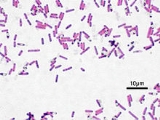
Bacilli
Encyclopedia
Bacilli refers to a taxonomic
class
of bacteria
. It includes two orders, Bacillales
and Lactobacillales
, which contain several well-known pathogens like Bacillus anthracis
(the cause of anthrax
).
" (capitalized and italicized) is also the name of a genus
that, among many other genera, falls within the class Bacilli. All types of bacteria are one-celled organisms that live alone or in chains or groups.
Also, "bacillus
" (or the plural "bacilli") can be a generic term to describe the morphology
of any rod-shaped bacterium. This general term does not mean that the subject is a member of class Bacilli or genus Bacillus. Thus, it does not necessarily imply a similar group of characteristics. Not all members of class Bacilli are rod-shaped (Staphylococcus
is spherical), and many other rod-shaped bacteria that do not fall within that class (Clostridium
is rod-shaped but very different taxonomically) exist. Moreover, the general term "bacillus" does not necessarily indicate the Gram-positive
staining common to class Bacilli. For example, E. coli is a rod-shaped bacterium that could, therefore, be described as "a bacillus," but it stains Gram-negative
and does not belong to genus Bacillus or class Bacilli. Some microbiologist
s have forsaken the general "bacillus" term because of the confusion it can create.
Taxonomy
Taxonomy is the science of identifying and naming species, and arranging them into a classification. The field of taxonomy, sometimes referred to as "biological taxonomy", revolves around the description and use of taxonomic units, known as taxa...
class
Class (biology)
In biological classification, class is* a taxonomic rank. Other well-known ranks are life, domain, kingdom, phylum, order, family, genus, and species, with class fitting between phylum and order...
of bacteria
Bacteria
Bacteria are a large domain of prokaryotic microorganisms. Typically a few micrometres in length, bacteria have a wide range of shapes, ranging from spheres to rods and spirals...
. It includes two orders, Bacillales
Bacillales
The Bacillales are an order of Gram-positive bacteria, placed within the Firmicutes. Representative genera include Bacillus, Listeria and Staphylococcus....
and Lactobacillales
Lactobacillales
The Lactobacillales are an order of Gram-positive bacteria that comprise the lactic acid bacteria. They are widespread in nature, and are found in soil, water, plants and animals. They are widely used in the production of fermented foods, including dairy products such as yogurt, cheese, butter,...
, which contain several well-known pathogens like Bacillus anthracis
Bacillus anthracis
Bacillus anthracis is the pathogen of the Anthrax acute disease. It is a Gram-positive, spore-forming, rod-shaped bacterium, with a width of 1-1.2µm and a length of 3-5µm. It can be grown in an ordinary nutrient medium under aerobic or anaerobic conditions.It is one of few bacteria known to...
(the cause of anthrax
Anthrax
Anthrax is an acute disease caused by the bacterium Bacillus anthracis. Most forms of the disease are lethal, and it affects both humans and other animals...
).
Ambiguity
There are several related concepts that make use of similar words, and the ambiguity can create considerable confusion. The term "BacillusBacillus
Bacillus is a genus of Gram-positive, rod-shaped bacteria and a member of the division Firmicutes. Bacillus species can be obligate aerobes or facultative anaerobes, and test positive for the enzyme catalase. Ubiquitous in nature, Bacillus includes both free-living and pathogenic species...
" (capitalized and italicized) is also the name of a genus
Genus
In biology, a genus is a low-level taxonomic rank used in the biological classification of living and fossil organisms, which is an example of definition by genus and differentia...
that, among many other genera, falls within the class Bacilli. All types of bacteria are one-celled organisms that live alone or in chains or groups.
Also, "bacillus
Bacillus (shape)
The word bacillus may be used to describe any rod-shaped bacterium, and such bacilli are found in many different taxonomic groups of bacteria. However, the name Bacillus, capitalized and italicized, refers to a specific genus of bacteria...
" (or the plural "bacilli") can be a generic term to describe the morphology
Bacterial cellular morphologies
Bacteria are classified by direct examination with the light microscope through its morphology and aggregation.The basic forms are spheres and round-ended cylinders . But there may be others such as helically-twisted cylinders , cylinders curved in one plane and unusual morphologies...
of any rod-shaped bacterium. This general term does not mean that the subject is a member of class Bacilli or genus Bacillus. Thus, it does not necessarily imply a similar group of characteristics. Not all members of class Bacilli are rod-shaped (Staphylococcus
Staphylococcus
Staphylococcus is a genus of Gram-positive bacteria. Under the microscope they appear round , and form in grape-like clusters....
is spherical), and many other rod-shaped bacteria that do not fall within that class (Clostridium
Clostridium
Clostridium is a genus of Gram-positive bacteria, belonging to the Firmicutes. They are obligate anaerobes capable of producing endospores. Individual cells are rod-shaped, which gives them their name, from the Greek kloster or spindle...
is rod-shaped but very different taxonomically) exist. Moreover, the general term "bacillus" does not necessarily indicate the Gram-positive
Gram-positive
Gram-positive bacteria are those that are stained dark blue or violet by Gram staining. This is in contrast to Gram-negative bacteria, which cannot retain the crystal violet stain, instead taking up the counterstain and appearing red or pink...
staining common to class Bacilli. For example, E. coli is a rod-shaped bacterium that could, therefore, be described as "a bacillus," but it stains Gram-negative
Gram-negative
Gram-negative bacteria are bacteria that do not retain crystal violet dye in the Gram staining protocol. In a Gram stain test, a counterstain is added after the crystal violet, coloring all Gram-negative bacteria with a red or pink color...
and does not belong to genus Bacillus or class Bacilli. Some microbiologist
Microbiologist
A microbiologist is a scientist who works in the field of microbiology. Microbiologists study organisms called microbes. Microbes can take the form of bacteria, viruses, fungi, and protists...
s have forsaken the general "bacillus" term because of the confusion it can create.

